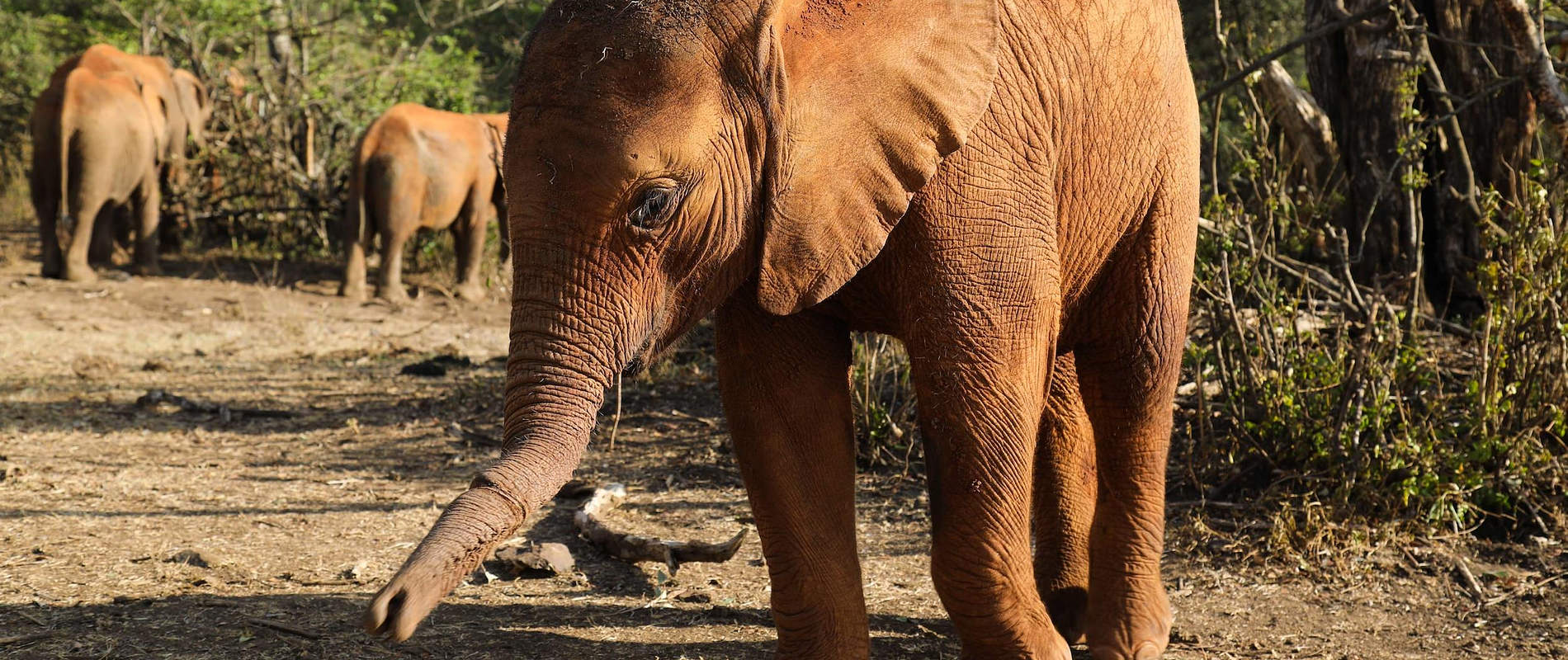This baby female elephant of approximately one year old was first spotted with a wire snare tight around her trunk on the evening of the 10th of Feb at Ngirare in the Mara Triangle, in amongst a large herd of wild elephants
This baby female elephant of approximately one year old was first spotted with a wire snare tight around her trunk on the evening of the 10th of Feb at Ngirare in the Mara Triangle, in amongst a large herd of wild elephants. Given the late hour, any hope of operating on her that evening was not possible, so the Mara Conservancy management arranged to have their Rangers monitor the herd overnight in order to be able to determine the whereabouts of the injured calf the next morning when the DSWT funded Mara Mobile Veterinary Unit working with KWS Veterinary Officer Dr. Campaign Limo could be called to the scene. During the night the herd moved to a forested area making it difficult to perform an operation in order to relieve the baby of the ghastly snare which was severing her trunk. The Mara Elephant Project's helicopter was called upon and Pilot Mark Goss was able to gently push the herd away from the dense thicket into more open terrain. It was evident that the baby was in excruciating pain.
The calf was immobilized using 1mg Etorphine hydrochloride delivered in a 1.5ml Dan- Inject dart from a vehicle, after which it took ten minutes for the drugs to take full effect. Meanwhile the mother was kept away to allow examination of the wound where the tight snare had cut deep into the trunk, almost severing it completely; leaving just a small portion intact. The teams were faced with three options: amputate the trunk, attempt to reconstruct it or leave it as it was. However none of these options could be undertaken under field conditions since constant monitoring and medication would be needed, added to which the calf would need to be watered and fed during recuperation. After much deliberation and consultation between the Mara Management and the KWS Vet, it was decided to capture her and transfer her to the DSWT Elephant Orphanage in Nairobi for possible surgical intervention. The wound was thoroughly cleaned and temporarily reconstructed before the baby elephant was airlifted to the DSWT Orphanage in Nairobi for further care.


She was given 20mgs Dexamethasone sodium anti-inflammatory intravenously and another 20mgs intramuscularly to ease pain and avoid shock but by the time she was on the plane the baby elephant was again fully conscious in transit. Of course taking a calf from its mother is never a decision taken lightly by the Kenya Wildlife Service, but it was felt that there was little option if this baby was to remain alive with an intact trunk.






The following day, a three hour operation was performed with three Vets in attendance in order to stitch together this little calf's trunk. The operation went well, but despite being heavily sedated for the days afterwards, she set about trying to dismantle all the painstaking stitching that has been done. An elephant's trunk is said to have 40,000 muscles, divided into as many as 150,000 individual units, and the constant contracting, expanding, wiggling and squirming, makes it very challenging to keep sutures in place.






It transpired that on the second day following the operation, "Enkesha"(as the baby was named) had managed to pop all her stitches, so we were back in square one! Amputation of the trunk was considered but we ruled that out, mindful that the tip of the trunk is extremely important when it comes to picking up food, and she would need her trunk to survive in the wild particularly through harsh dry seasons. Any further operation was also ruled out given that she had already had two in quick succession, and another could risk her life, since the revival drug was still in her system, meaning that there was the risk that she may not be able to be brought round again following further immobilization.


We have since worked extremely hard to keep Enkesha happy and engaged, ensuring that she is kept infection-free so that natural healing can progress. Amazingly her wound is healing well although it is a slow and painstaking journey, and we don't anticipate that it will mend entirely, but at least part of it has knitted together again making the original gaping hole much smaller than previously. During the time that the wound was so painful, we were able to give her both milk and water by mouth so her body condition did not deteriorate dramatically. In all, Enkesha's improvement has been remarkable, and the ability to use what is left of her trunk has exceeded our expectations. Snaring of wildlife for bush meat poaching on the fringes of the Mara happens, and the Mara Conservancy works hard to prevent such practices with very efficient anti-poaching scouts working day and night. It would be one of these snares, most likely set to ensnare a herbivore, that indiscriminately entangled this baby calf. When she struggled the snare would have wrenched taught and eventually, in her case, she managed to pull free from the anchor point, but not before she had a wire tourniquet severing her trunk. It had been there for some time before she was first sighted and helped, and it was this cruel twist of fate which robbed her of her family, but thankfully not her life. We feel sure she will mend in the fullness of time, enough to live a totally viable wild life once more.




























